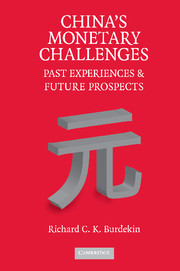Book contents
- Frontmatter
- Contents
- Preface
- Introduction: China Today and Lessons from the Past
- PART I CHINA'S EXCHANGE RATE REGIME AND MONETARY POLICY
- PART II THE IMPORTANCE OF INTERNATIONAL FACTORS, PAST AND PRESENT
- 5 US Pressure on China and Hong Kong in the 1930s
- 6 Inflation Transmission to Taiwan in the 1940s
- 7 WTO Challenges and China's Banking Sector Today
- PART III THE PEOPLE'S REPUBLIC'S ROLE WITHIN GREATER CHINA AND ASIA
- 10 Conclusions and Future Prospects for the Renminbi
- References
- Author Index
- Subject Index
7 - WTO Challenges and China's Banking Sector Today
Published online by Cambridge University Press: 06 July 2010
- Frontmatter
- Contents
- Preface
- Introduction: China Today and Lessons from the Past
- PART I CHINA'S EXCHANGE RATE REGIME AND MONETARY POLICY
- PART II THE IMPORTANCE OF INTERNATIONAL FACTORS, PAST AND PRESENT
- 5 US Pressure on China and Hong Kong in the 1930s
- 6 Inflation Transmission to Taiwan in the 1940s
- 7 WTO Challenges and China's Banking Sector Today
- PART III THE PEOPLE'S REPUBLIC'S ROLE WITHIN GREATER CHINA AND ASIA
- 10 Conclusions and Future Prospects for the Renminbi
- References
- Author Index
- Subject Index
Summary
[T]he State must take a dominant controlling share in the State-owned commercial banks in order to keep the economic lifeline of the country in state's hands and fending off financial risks.
(Chinese Premier Wen Jiabao, 2006)Introduction
When China's economic reforms began in 1978, government control over banking activities was absolute. The People's Bank of China functioned not only as a central bank but also as a loan-issuing bank. There was no real banking system in place outside the People's Bank and no established markets for bonds or stocks. However, the dismantling of the old “monobank” system has been followed by some dramatic changes following China's World Trade Organization (WTO) entry in December 2001. Joint-stock ownership was established in three of the largest state banks, coupled with foreign ownership stakes and the gradual opening of China's market to foreign banks. The government still exercises dominant control over the banking system, though, and the major banks required government injections of funds to shore up their balance sheets. This chapter considers the evolution of China's state-owned banks since the reforms of the 1990s and the actual and potential impact of China's WTO membership. Despite the improvements that have been made, we argue that freer foreign competition may be needed to bring about a more market-oriented lending system and promote adequate funding opportunities for China's rapidly growing private sector.
- Type
- Chapter
- Information
- China's Monetary ChallengesPast Experiences and Future Prospects, pp. 136 - 162Publisher: Cambridge University PressPrint publication year: 2008
- 2
- Cited by



